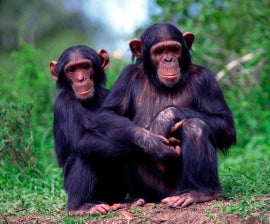
Our closest relatives face many threats. © Veer
At one time, Africa’s chimpanzee population was believed to have been one million, but today, there are no more than 150,000 individuals left. Wild chimpanzees are already extinct in four of their former range countries on the continent, and their population continues to decline in the remaining 21 African nations in which they survive. Only 10 of these nations have chimpanzee populations exceeding 1000.
Guinea has one of the largest estimated populations of the western chimpanzee, at 25,000, while Sierra Leone’s chimpanzee population is believed to be less than a tenth of that.
Threats to survival
The main threats to chimpanzee survival in Africa are:
- the expansion of agricultural and living space for the human population
- industrial logging
- bush fires
- poaching for bush meat
- the live capture of young chimpanzees for the pet trade
The majority of Guineans are Muslims who observe taboos against the hunting and eating of chimpanzees. However, the forest region which borders Sierra Leone and Liberia is predominantly Christian and animist. In this zone, there are no taboos pertaining to the hunting of chimpanzees, and poaching does occur.
Communication with the public presents another set of challenges. Most of the population in both Guinea and Sierra Leone live in rural, agricultural areas with limited access to newspapers and television. High illiteracy rates in both nations also limit the effectiveness of outreach.
Legal protections and law enforcement
In Guinea, the capture, hunting, and eating of chimpanzees is already prohibited, but law enforcement authorities lack sufficient capacity to enforce such prohibitions. Since the early 1990s, the influx of refugees fleeing from the long civil war in Sierra Leone and related turmoil in Liberia, has resulted in additional pressures on chimpanzees and their habitat in Guinea.
In Sierra Leone, wildlife laws predate the advent of CITES (Convention on International Trade in Endangered Species) in 1972, and legal protection for chimpanzees is weak. During the 1960s and 1970s, Sierra Leone was a major exporter of chimpanzees to research institutions worldwide, until worldwide pressure organized largely by primatologist Geza Teleki led to a de facto ban on the practice that has lasted more than 30 years. Most scientists use Teleki’s estimates of 2000 from the early 1980s. However, with non-viable population clusters and the uncertain effects of Sierra Leone’s decade-long civil war, the number of surviving chimpanzees may actually be lower.
Saving chimpanzees where it counts
Only a few issues in international wildlife protection today garner more public attention than the plight of great apes. In the developed world, the animal protection community has often emphasized the strong genetic heritage and developed emotional and social capacities of chimpanzees, gorillas, orangutans, and bonobos as part of an argument that these animals deserve heightened moral and legal consideration.
In less developed nations, the challenge of ensuring basic protection for chimpanzees is more elemental, because they face daily threats from the human population with whom they share their environment.
The Chimpanzee Conservation and Sensitization Program (CCSP) is a collaboration between several large international chimpanzee and animal welfare organizations to aid local and national institutions in Guinea and Sierra Leone. It is one of many projects that Humane Society International is involved in. The hope is that, by involving local leaders, educators and law enforcement personnel, the plight of chimpanzees can be better understood around the world and the push to save these endangered animals will gain widespread support.
